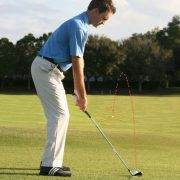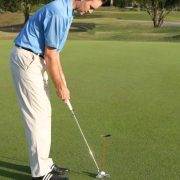Golf Short Game Strategies and Shot Selection

I consider the short game to be every shot that we hit from a distance inside of a full swing with our shortest iron. For instance, if we hit a full lob wedge 75 yards, then the short game begins from that point to the hole. This accounts for at least half of the game, therefore warrants plenty of our practice attention.
With full shots, it is widely recognized that direction is the more challenging variable as opposed to distance control. However, once we start making partial swings, distance control becomes the more crucial element. For example, it’s pretty easy to get a chip shot more or less on line, but more challenging to get the distance correct.
My first rule of thumb applies to all short game shots, or less than full swings. It sounds simple and obvious, but surprisingly few players will do it. With a given club, if you want to hit the ball shorter, make a shorter backswing. If you need to hit the ball a little bit further, make a little longer backswing. All else remaining constant, the length of your shot should correlate to the length of your swing. With a little practice, this simple concept will help you gain feel and calibrate distance in your short game.
My second main short game strategy has to do with shot selection. With beginners and higher handicappers, I suggest putting whenever reasonably possible. If the putter is not appropriate, consider using a flatter faced iron such is a 6 or 7-iron. These shots carry far less risk and get the ball rolling as soon as possible. Beginners should only use lofted wedges around the greens when absolutely necessary. Use these types of pitch shots and lofted chip shots when you need to hit the ball over something, such as a bunker, or if you are chipping and pitching out of heavier grass. Keep it simple, become proficient at the safer type chip shots, before taking greater risks with high pitches and flop shots.
Also, when you are chipping and pitching, consider where the ball is landing. As a rule of thumb, we want to land our pitches and chips on flat ground, or in troughs or depressions, as opposed to pitching the ball on the tops of hills or rises. If we plan to aim a pitch shot on the top of a hill, and leave the shot just a little bit short, the ball will hit into the face of the hill and stop well short. Conversely, if we hit the shot too hard, the ball will land on the backside of the hill, bound forward, and roll out too far. This gives us a very narrow margin for error when it comes to controlling the distance of the shot. While flat services hold true, troughs will actually serve to help you in this regard. If the chip or pitch is short of the intended landing area, it will hit the downslope of the trough and kick the ball forward closer to the correct distance. If the shot travels too far in the air, it will hit the upslope of the trough, which will slow the ball down, likely releasing closer to the correct distance as well. Landing chips and pitches in troughs provide much more margin for error than landing these shots on the tops of hills.
My final short game thought has to do mostly with putting and also to a degree with chipping. Recognize that most players, especially beginners, rarely play enough break when hitting chips and putts along slopes. We will talk more about reading greens, but as a rule of thumb, don’t be afraid to aim away from the hole and account for break, perhaps much more than you would think. Once we’ve accounted for slope appropriately, each shot should be played as if it were straight.
In summary, I consider the short game to be every shot that you hit that is within less than a full swing distance from the green. This accounts for more than half of the game for most players, and I encourage you to spend plenty of your practice time on this area. With less than full shots, we want to let the length of your swing correlate to the length of the shot. This sounds simple but few people do it. In terms of shot selection, putt whenever possible, chip next, and pitch the ball into the air only when absolutely necessary. When planning your short shots, look to land the ball in troughs or on flat surfaces as opposed to on the tops of hills. This will provide you with much more margin for error in controlling your distance. Lastly, don’t be afraid to play plenty of break if you’re hitting your chip or putt along the side of a slope. Playing too much break is better than playing too little, you’ll generally leave yourself closer to the hole.









